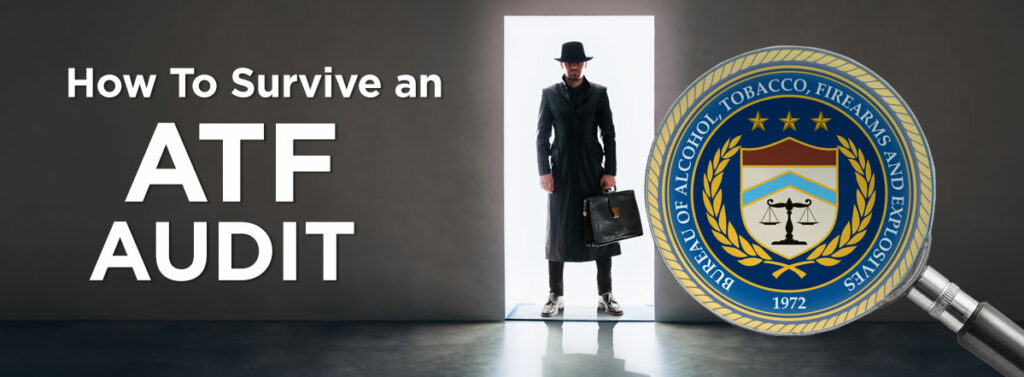
Surviving an ATF audit begins long before the ATF walks in the door; long before you sell a firearm; in fact, before you receive your first firearm. Surviving an ATF audit begins even before you apply for your FFL. You must understand that the ATF’s primary responsibility is Public Safety and that you as an FFL are the frontline in the ATF’s fulfillment of that responsibility. You are the one who will determine whether a firearm should or should not be transferred to someone.
Understanding the purpose of the Audit:
With that in mind, let’s consider why the ATF audits FFLs. The audit is the number one way they can make sure that you are doing your part in fulfilling their mission of Public Safety. Understand that the audit helps them ensure that you are complying with the laws and regulations governing firearms transfer; and that you are doing your part to assure that firearms are not being illegally transferred. Your records help to show this.
Prepare for your Audit
If you wait until the day the ATF walks in your door to prepare for your audit, you are likely to have many failures. Your daily goal should be 100% compliance so that when the audit happens, you will have no errors. According to a recent verbal report by the Deputy Assistant Director of Field Operations to an Importer/Exporter Compliance Conference sponsored by NSSF (National Shooting Sports Federation), that happened about 61% of the time in the past year with audits of Importers. That’s impressive, but it means that about 2 of 5 inspections had other results.
Train Your Staff
While we would like to think that everyone should be able to think logically about compliance, that is not the case. There is much common knowledge about firearms that is wrong. You must train your staff regularly to keep people focused on proper compliance practices. When in the heat of receiving or shipping that big order, it is easy to forget, or think, “I’ll do it tomorrow.”
Establish procedures and train your staff on the proper actions when the ATF walks in the door.
- Make sure your staff knows that the ATF has a legal right to inspect you annually and that failure to allow an audit will result in loss of your FFL.
- Make sure your staff knows who your Responsible Parties are and has their cell phone numbers in case they are not in the building.
- Don’t answer questions, deferring to the Responsible Parties to answer questions.
- Make sure that your Responsible Parties know how to use your electronic bound book software to provide data to the IOI. You may wish to provide a limited permission user to the IOI to examine your records.
- Alert Compliance Counsel to the presence of the Auditors.
- Make sure that all firearms are stored safely and securely.
Audit Your Own Performance
Conduct your own internal audit to see how well your compliance system is working. You may wish to involve your outside legal counsel in an audit to get a third-party opinion on the completeness of your procedures and internal audit process. A few dollars spent at this stage can save you many thousands later.
- Are Bound Book records up to date?
- Are they recorded accurately and on-time?
- Are your 4473s completed and filed properly?
- Does your NFA inventory match the NFRTR records? Can you find the paperwork for each firearm?
- Does the firearm serial number on the firearm (not on the box) match your Bound Book record?
- Are all your firearms in inventory recorded in your bound book?
- Do you have open Acquisition in your bound book that are no longer in your inventory?
- Have you made corrections in your bound book to match incorrect Acquisition or Dispositions made in your accounting software?
Maintain Accurate Records
The number one way you demonstrate your good faith effort in being a valuable partner with the ATF, is to maintain good records. Notice that we said earlier, “firearms transfer”. We tend to think of buying and selling as separate from repairing and shipping; or conducting a private party. However, for record-keeping, the ATF considers everything to be a transfer, whether you sell it or not. The ATF only uses buying or selling to determine whether you are or should be an FFL.
What records do you need to keep?
- Bound Book – your record of Acquisitions and Dispositions. An Acquisition is any transaction that brings a firearm into your “domain and control”, In other words, any action that places a firearm in your possession; whether it is permanent or not. Any transaction that places a firearm in your possession from one business day to another is an Acquisition. Any transaction that removes a firearm from your possession is a Disposition. (Remember, “your possession” includes business use away from your premises by an employee.)
- What do you need to record?
- Firearm Details (Serial Number, Manufacturer, Caliber, Model, maybe Importer)
- Who did you acquire it from (Name and either Address or Federal Firearms License)
- Date of Acquisition
- To whom did you transfer it (Name and either Address, 4473 serial number or Federal Firearms License)
- Date of Disposition
- When do you need to record it? Best practice is to record it the day the Acquisition or Disposition takes place because one of the top citations during an inspection, is failure to record Acquisitions in a timely manner.
- Electronic record keeping (like Easy Bound Book) is almost becoming required by the ATF. There are no federal regulations requiring it, but it is required in some states. Many customers have come to us because their IOI (Industry Operations Investigator) strongly suggested that they move to electronic records. Electronic record keeping significantly simplifies and reduces the amount of time required for good A&D record keeping.
- What do you need to record?
- Form 4473 for transfers to a non-licensed individual
- Make sure that the form is fully and accurately completed, including the NTN number from your NICS check (if you live in a NICS state).
- Make sure that the form is signed by the transferee and by the transferor.
- Electronic 4473s (like our Easy 4473) help you avoid mistakes and make sure that your form is correct.
- NFA forms showing proper acquisition of a National Firearms Act firearm
- Keep your paper copies filed in such a way that it is easy to find them to support your possession of the firearm.
- We recommend that you make an electronic copy of the documents and attach them to the Acquisition and Disposition record in your bound book.
- Multi-gun and Lost/Stolen firearms documentation
- Other documents you may need
- License application
- Ownership records, including changes in ownership (obviously, you will report these to the ATF when they happen so that you can get a new license).
- Any documentation from Fire, Police, City Inspectors showing that you are in compliance with city, county and state laws and regulations
- Time to Crime reports you have filed
- Copies of backups from your electronic record-keeping system (required daily)
- At least the last copy of your printed bound book (required every six months). This can be an electronic copy, like a pdf
- Trace request responses
During the Audit
Remember that you are a partner in the ATF Public Safety mission, but you are also the one being regulated and being audited.
- Alert Compliance Counsel to the audit.
- Seat the ATF IOI’s in a neutral area for the opening conference. This will include:
- A preview of what will happen during the audit
- A review of all your ownership and corporate structure
- Compliance documents from your city, county and state
- Other topics that may be of relevance
- Provide the ATF with the requested information. Generally, this will include:
- Bound Book listing of open firearms
- They may also ask for all firearm transactions
- An electronic list will be most helpful
- Access to your 4473 records as requested
- Access to your NFA records as requested
- Bound Book listing of open firearms
- Assign someone to work with the ATF while conducting the physical audit of your firearms.
- Direct the ATF to locations of firearms
- Assist the ATF in evaluating and addressing discrepancies in records and firearms
- Make sure that your Responsible Parties are the ones answering questions.
- Be honest; answer the questions providing a complete answer to the questions, but not more.
- Make a note of all questions, findings, recommendations, and actions taken.
- Understand the results of the closing conference. Make certain that you understand any issues presented by the ATF and have fully documented them.
Following the Audit
- If any deficiencies or issues are presented:
- Develop a written remediation plan (with the help of your legal counsel).
- Implement it immediately.
- Adjust your training and procedures to reflect the strengths and weaknesses revealed during the audit.
- Continue to train and self-audit following the completion of the audit.
Final Thoughts
You are in a highly regulated business with many moving parts. Electronic bound book and 4473 software can help you monitor your internal compliance efforts and make the process easier, faster and more accurate. We have been involved in and have written ATF compliance record-keeping since 2008. We know and understand the issues you are facing. Let us help you.
